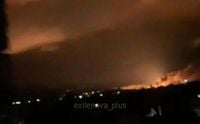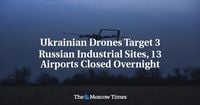In a dramatic escalation of its campaign against Russia’s wartime infrastructure, Ukraine has intensified drone and missile strikes on Russian oil refineries, depots, and chemical plants, inflicting severe damage and sparking a fuel crisis that now ripples through the Russian economy and daily life. The attacks—striking targets up to 2,000 kilometers from the Ukrainian border—have become a near-daily occurrence, a reality few would have imagined at the onset of Moscow’s full-scale invasion in 2022. But as October 2025 draws to a close, these strikes are not only routine—they are reshaping the economic and psychological landscape of the conflict.
According to BBC and the Kyiv Independent, on the night of October 29, Ukrainian drones from the Security Service’s Special Operations Center “A” struck two oil depots in the occupied Crimean villages of Hvardiiske and Komsomolske. The attacks destroyed a Pantsir-S2 self-propelled anti-aircraft system worth an estimated $20 million and two radar stations. Powerful explosions rocked the Hvardiiske depot, which belongs to ATAN—Crimea’s largest network of fuel stations—while a fire at the Komsomolsk site sent thick black smoke billowing into the sky. Local residents reported seeing military fuel trucks entering and leaving the facilities the night before, underscoring the depots’ role in supplying Russian military units in occupied Crimea.
Just hours later, Russian proxy governor Sergey Aksyonov confirmed a Ukrainian drone strike on a fuel container in Simferopol, the Crimean capital, igniting a fire but reportedly causing no casualties. Emergency services scrambled to contain the blaze as it spread to additional fuel tanks. The facility is a key supply point for Russian occupation forces, and the attack marked yet another blow to Moscow’s ability to sustain its military operations in southern Ukraine.
Ukraine’s strikes were not limited to Crimea. The same night, Ukrainian Special Operations Forces hit three major oil-and-gas facilities deep inside Russia: the NS-Oil refinery in Novospasskoye, Ulyanovsk Oblast; the Maryinsky Oil Refinery in Tabashino, Republic of Mari El; and the Budyonny Gas Processing Plant in Stavropol Krai. Explosions and fires were confirmed at all sites, with local residents posting videos of the infernos. The Maryinsky Refinery processes 1.6 million tonnes of oil annually, producing ten types of petroleum products. The Novospassky Refinery adds another 600,000 tonnes of capacity, while the Budyonny Gas Processing Plant supplies 2.2 billion cubic meters of gas per year to local power plants and Lukoil facilities. All three are vital to Russia’s energy sector and, by extension, its war effort.
These attacks are part of a coordinated Ukrainian campaign that has, since early 2024, dramatically intensified. As UNITED24 Media reported, 21 of Russia’s 38 major refineries have now been struck at least once—a 48% increase in successful attacks compared to all of 2024. The impact has been profound. By late September, nearly 40% of Russia’s oil refining capacity—about 338,000 tons of crude oil per day—was offline, according to analytics firm Seala cited by The Moscow Times. The resulting fuel shortage is the worst Russia has experienced in decades, with gasoline prices rising by 10% since January—the sharpest increase in 15 years. A poll from online finance platform WEBBANKIR found that 74% of Russian drivers have noticed price hikes since August, and 90% expect further increases. Over 40% of drivers have changed their driving habits, and 18.9% have encountered empty gas stations. Some outlets have resorted to selling low-quality fuel, according to the Russian Union of Car Services.
The economic ripple effects extend far beyond the pump. Russian oil product exports dropped by 17.1% in September compared to August, totaling 7.58 million tons, according to Reuters. Exports through Baltic ports fell by 15.4%, while Black Sea and Azov ports saw an even sharper 23.2% decline. To fill the gap, gasoline shipments from Belarus to Russia by rail increased fourfold in September, a direct response to shortages caused by Ukrainian strikes.
Ukraine’s leadership has been candid about its strategy. President Volodymyr Zelenskyy told reporters on October 28, “This is their war money—from oil refining. That’s why we’re targeting it.” The strikes, he added, are a priority because they directly finance Russia’s aggression. Ukrainian-made drones, produced in ever-greater numbers, have enabled Kyiv to expand the scope and frequency of these attacks. “We have drones, and we know how to produce them,” Zelenskyy said in September. “Everything depends on how many we can use in a day. Judging by the results of recent operations, it’s clear that we’ve started using more drones.”
Kyrylo Budanov, head of Ukraine’s Main Intelligence Directorate (HUR), argued at the Kyiv International Economic Forum that strikes on Russian oil refineries have inflicted more damage on Moscow’s revenues than Western economic sanctions. “The financial impact of the strikes is a mathematical truth,” Budanov said. “But in conjunction with what we are doing, it will yield results and is already yielding them.”
The military dimension of these attacks is equally significant. Ukraine’s drone campaign has targeted not only energy infrastructure but also Russian defense factories, including the Basalt ammunition plant in the Moscow region, the Splav MLRS manufacturer in Tula, and the Energia plant in Lipetsk Oblast, which produces components for Iskander and Kinzhal missiles. The cumulative effect of these strikes is mounting economic difficulty and logistical strain for Russia’s military.
Western governments have largely supported Ukraine’s right to strike Russian military and energy targets. The United States has reportedly provided intelligence to help Ukraine plan long-range attacks, while French Foreign Minister Stéphane Séjourné stated in April that “the Ukrainian people are acting in self-defense, and we consider that Russia is the aggressor.” Finnish President Alexander Stubb echoed this stance, saying, “The only language is the language of power. It is available in Russia. Whoever is responsible for these attacks in Russia, the question remains the same: is it a question of the oil price, or do we have difficulties with it? War entails collateral damage, and whoever attacks [Russian refineries] knows what they are doing; they do it skillfully, without endangering civilians, and this needs to be kept in mind.”
Russia, for its part, has responded with continued artillery strikes on Ukrainian cities, such as the October 29 bombardment of a children’s hospital in Kherson that injured nine civilians, including four juveniles. US intelligence officials, briefed in October, assess that President Vladimir Putin remains determined to continue the invasion despite heavy losses and mounting economic woes.
As Ukraine’s drone and missile campaign continues to disrupt Russia’s fuel supplies and military logistics, the war’s frontlines are no longer confined to the trenches of the Donbas or the streets of Kherson. Instead, the conflict is increasingly fought in the skies—and on the balance sheets—of a Russia whose war machine is beginning to sputter under the weight of relentless, high-tech pressure from its smaller neighbor.


